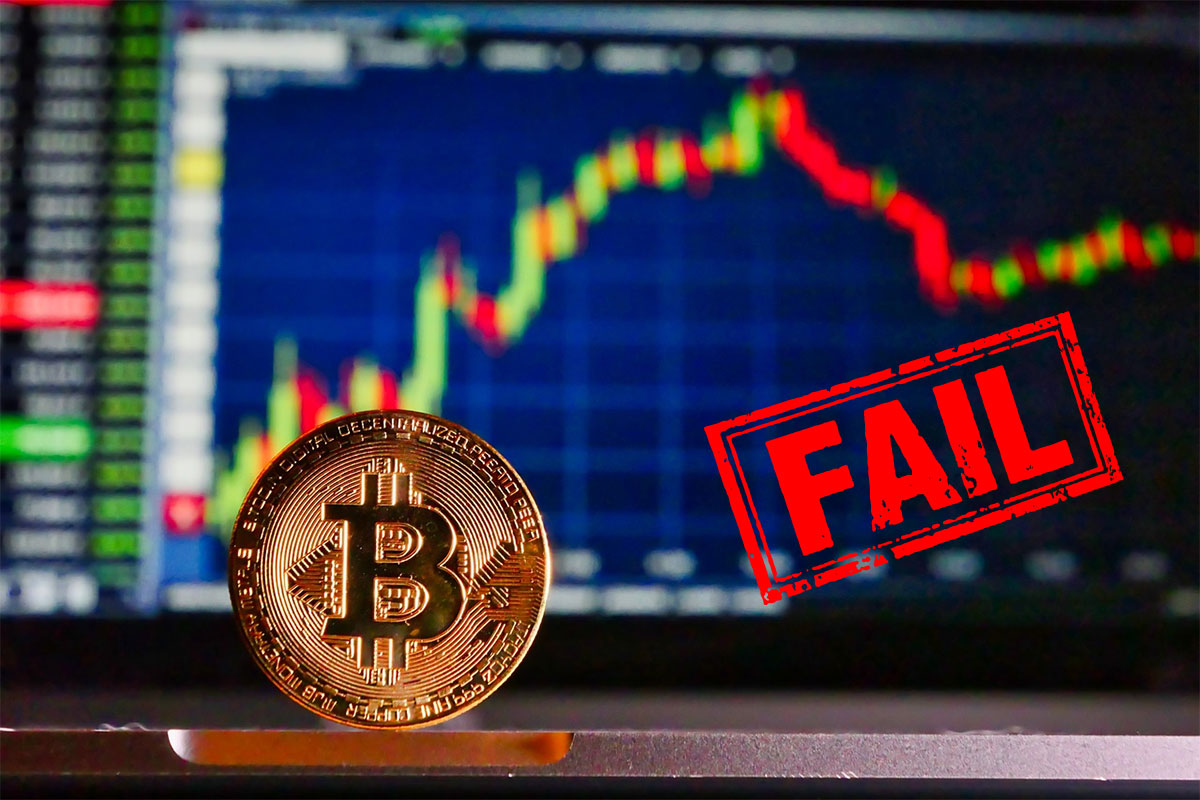Crypto is an emerging market with ups and downs pertinent to any nascent technology. This year’s economic turbulence has had a tremendous impact even on stable traditional assets, not to mention the innovations deemed uncertain in the public eye.

Since cryptocurrency trading gained traction, over a thousand cryptocurrencies have failed in various circumstances. Be it hacking, theft, lack of trade volume, or poor project planning, cryptocurrencies often fail. Just as it happens with startups, most cryptocurrency projects fail in the early stages. However, sometimes large crypto ecosystems fall down as well. That sends ripples across the whole industry, often causing a domino effect on smaller companies.
Moreover, global uncertainty and bankruptcies of major crypto industry players have brought many crypto projects to the verge of extinction this year. Today, we’ll explore the biggest crypto failures occurring in 2023 so far, their reasons and consequences, and the losses they caused to the crypto community.
Did many cryptocurrencies ‘die’ in 2023?
We have analysed the list of ‘Dead Coins’ provided by Coinopsy to explore the cryptocurrencies that stopped trading in 2023. The firm uses a few criteria to consider a token ‘dead coin’. Crypto must be abandoned or used as a scam to appear on the ‘dead’ list. Some signs proving the project is over are that their website is down, the blockchain has no nodes, the crypto system has wallet issues, it doesn’t have social updates, the token has too low or zero trading volume, or developers have publicly walked away from the project.
For you to understand the overall situation, here are a few key stats:
- There are over 2,400 dead coins registered for the last dozen years.
- Abandoned coins with close-to-zero trading volume accounted for 66.5% of analysed crypto failures over the last decade.
- About 22% of failed projects ended up being scam coins, and 10% failed to launch after an unsuccessful ICO.
- 2018 was the most fatal year for cryptocurrency. Then 751 coins failed, as bullish market speculation didn’t materialise.
- 91% of coins from 2014’s crypto crash are now dead.
Frankly speaking, this tough year hasn’t ‘killed’ too many cryptocurrencies. In fact, their number is less than ten. Some of the projects like Flourishing AI or Trillant still exist, but the trading volumes are low. Moreover, the latter is raising many red flags and has a low credibility score, potentially being another rug-pull scam.
However, there was one notable cryptocurrency failure we discovered, and that is…
CluCoin
The project appeared in 2021, positioning itself as a charity-focused cryptocurrency. The key founder of the initiative was a person hidden behind the DNP3 nickname. Besides this crypto project, DNP3 also founded Gridcraft Network, a play-to-earn web3 game, Goobers NFT collection and other web3 projects.
In January, it became known that CluCoin’s founder used customer funds in casino gambling and lost all the money. While DNP3 went on with fighting his addiction, the project’s team stumbled at a crossroads.
According to DNP3, the sum lost in gambling was “around $500k”, although many investors believed there was more. At least over 2.3 million dollars worth of transactions remained unaccounted for.
The price of CluCoin immediately went down by approximately 72%. Its total supply was immense – 1 quadrillion, with almost 30% of the token going into circulation. The CluCoin market cap stood at about $1.5M as of August 2022. The current market cap is $142, as the token with a minuscule price is still technically present at some trading exchanges.
On the other hand, we have an interesting example of an attempted crypto failure in 2023.
The ‘Token Dump’ case of Umami DAO
Umami Finance is a set of smart contracts which operates as a DeFi protocol providing yield vaults for risk-hedged yield on crypto assets, including ETH, USDC, and BTC. In early February 2023, Umami’s now-ex-CEO Alex O’Donnel dumped his large share of UMAMI tokens. The rug-pull came unexpectedly, and the rest of the Umami team were shocked. Nevertheless, they continued to move Umami towards decentralisation and a DAO structure. The team members assured the community that the treasury assets were safe under the “control of the multisig who will obey the direction of Umami DAO and its token holders.”
On February 24, the team announced that rewards for the network stakers had been restored. After a lengthy process of voting and audits, Umami has presented a limited Whitelist and Beta Launch mechanics for the upcoming Deconstructed GLP Vaults, set to go live in the first days of July.
The UMAMI token that plunged 50% from $22 to $11 following CEO’s “rugging” is now trading at $16.59, being on the rise since June 20. It is, of course, a small fraction of the token’s record high of $162 in December 2021. After all, the crypto community is still cautious about the project. And yet, investors understand that rug-pulling, which has plagued numerous crypto projects, is not a risk exclusive to the crypto industry and is an even more common occurrence in traditional finance.
Failed crypto companies
While all major cryptocurrencies managed to stay afloat this year, the same can’t be said about crypto-related businesses. Since the FTX bankruptcy in November 2022, the regulators unleashed all their scrutiny against crypto firms, warning investors about the industry “dangers”.
It is especially evident in the US, where crypto traders are targeted by the government in general and separate bodies like the Securities and Exchange Commission (SEC). Therefore, this year we’ve seen numerous examples of bankruptcies or branch closures of US crypto players.
Genesis
In January, after several months of disputes, crypto broker Genesis decided to file for Chapter 11 bankruptcy protection. The lender ran into problems shortly after the FTX crash. Along with its owner, the crypto conglomerate Digital Currency Group, the company has been negotiating with creditors since mid-November 2022. The crypto broker owed over $3 billion, including $900 million to Gemini clients and €280 million to the Dutch Bitvavo exchange.
The crypto exchange Gemini used Genesis as its primary lending partner under the crypto “earn” program. About 340,000 Earn users have been unable to access their funds since November 2022, when Genesis halted withdrawals quoting the volatility in the crypto markets. In February 2023, Gemini and Genesis reached a $100 million agreement “on a plan that provides a path for Earn users to recover their assets.”
Silvergate, Silicon Valley Bank, and Signature Saga
Although all the institutions mentioned above are not crypto companies, the closure of three major crypto-friendly US banks that held significant assets of various blockchain projects and companies had a profound impact on the crypto industry. Happening within a short period of time, these closures narrowed the banking opportunities for crypto firms of all sizes. For many years, Silvergate’s Silvergate Exchange Network (SEN) and Signature Bank’s Signet platforms enabled round-the-clock real-time payments, facilitating crypto-to-fiat exchange. Now, crypto players are forced to look for alternatives which might be much more expensive and less risk-tolerant.
Reportedly, the downfall of Silvergate has been linked to regulatory pressure on banks that accept cryptocurrency deposits. Besides, the bank had a direct connection to the beleaguered FTX, so its transactions with the bankrupt crypto exchange and the affiliated Alameda Research were extra scrutinised within the fraud investigation.
At the same time, the bank denied any fiscally-meaningful connection to the disgraced crypto exchange, citing its relationship to FTX as “limited to deposits”. That was, for sure, before the ‘voluntary’ shutdown.
The closure of another crypto-friendly institution 一 the Silicon Valley Bank – also had a major impact on tech startups and venture capital (VC) firms. Most of the funds held in SVB, which was closely associated with the high-risk technology industry, were not insured. Many VC investors also kept their money in the Silicon Valley bank that came under the management of the Federal Deposit Insurance Corporation (FDIC) and ultimately was sold to First Citizens Bank. Meanwhile, its British arm was successfully purchased by legacy banking giant HSBC.
In March, FDIC announced the third part of this puzzle – Signature Bank – would be sold to Flagstar Bank, a subsidiary of New York Community Bancorp. The New York-based bank was one of the largest lenders in the crypto industry. As of December 31, 2022, the total assets of the bank were equal to $110.4 billion, and the total amount of deposits was $88.6 billion.
SEC vs Binance
The final case is still ongoing. Yet it is another brilliant example of regulators squeezing crypto companies out of the market.
On June 6, US SEC sued one of the most popular crypto exchanges globally – Binance. Through thirteen charges on 136 pages, SEC alleged that Binance and its CEO ‘CZ’ Changpeng Zhao “engaged in an extensive web of deception, conflicts of interest, lack of disclosure, and calculated evasion of the law.”
Among other things, SEC claimed that the crypto exchange has been misleading investors about the actual ownership of the Binance.US trading platform. Besides, the regulator alleges that although Binance publicly affirmed US customers were restricted from transacting on the firm’s international exchange, the firm and its CEO “subverted their own controls” to violate this rule.
While the SEC sought to freeze Binance.US assets, the order of U.S. District Judge Amy Berman Jackson obliged the two parties to work on a compromise arrangement that would allow the exchange to avoid asset freezing.
This legal case is only starting to unfold. However, it has already caused a lot of troubles to the international crypto exchange. Binance.US suspended U.S. dollar deposits on June 13 and paused its relationship with US banking partners.
Influence on Binance regional businesses
Moreover, the US law case apparently influenced the attitude towards Binance in other countries.
First, the Nigerian SEC also targeted Binance a few days after the US suit became public. The regulator issued the warning stating that Binance is operating illegally in the West African country. In addition, the commission urged Nigerians to refrain from investing in crypto assets or crypto-related financial projects that aren’t registered or regulated by the government.
Next, Binance announced it had decided to leave the Netherlands. After unsuccessful attempts to pass the registration procedure with the financial authorities of this country, Binance didn’t manage to get the status of a virtual asset service provider after all.
The firm was also forced to revoke its registration in Cyprus and cancel registration in the UK amid enhanced regulatory checks. With this move, none of the cryptocurrency exchange’s subsidiaries has the authority granted by the FCA to carry out activities in the UK.
Although the company isn’t giving up, looking for new trading markets (like Kazakhstan), it cannot substitute the loss of presence in major crypto hubs.
To compare, Kazakhstan ranks 61 in the Global Crypto Adoption Index by Chainalysis, while the US and UK rank 5 and 17, respectively. The Netherlands are in 39th place among the 146 countries examined.
Even before the SEC indicted Binance for numerous violations of the existing law, the crypto exchange left the Canadian market (ranked 22 in the global index) due to the tightening of new regulations.
What if Binance loses the case?
The next hearing for the SEC vs Binance case is scheduled for July 13, so we’ll have to wait and see how the story unfolds.
The potential loss of Binance would be the worst-case scenario for the crypto industry, which has already suffered from a number of hits in 2023 and the year before. Therefore, industry players should prepare for the worst outcome, which would definitely bring more market volatility.
Long before the SEC allegations got formalised in a legal case, advisors expected more cryptocurrency failures in 2023 than we saw last year. “I don’t know if there will be anything as large and centralised as the fallout from FTX, although Binance hasn’t fallen yet and was the biggest competition to FTX,” said Saira Rahman, VP of new investor initiatives for Fundrise, an online alternative investment platform.
Today, Binance is the market leader and the largest centralised exchange in the world with a market share of 62.1%. The exchange was used for more than 50% of the total spot trading volume between 2022 Q4 to 2023 Q1. Thus, its possible fallout would be no less harmful to the market than the FTX bankruptcy.
Now, the future of Binance hangs by a thread. Besides, the SEC also initiated the ongoing legal battle with Coinbase, not to mention the high-profile Ripple case that has been going on since 2020 and allegedly is nearing the final stages.
Coinbase is the most dominant centralised crypto exchange (CEX) in the U.S. — accounting for 76.2% of the country’s total market share and the 4th largest CEX globally. Its market significance shouldn’t be underestimated too.
As for Ripple, its activities are crucial for many countries which have chosen the company as a partner for their CBDC projects (e.g. Montenegro and Colombia) or may consider using its comprehensive CBDC platform in the future.
Will the cryptocurrency market survive another major failure?
Our subjective opinion is that it will. The technology is rapidly evolving, and the market can come up with many alternatives to any failed crypto project. The only condition is for global regulators to provide clear rules on play. Since crypto is here to stay, all the legacy laws should be adapted to the new realities, allowing fintech innovations to develop for the customers’ benefit.
At the same time, smaller crypto firms should not waste their time and improve their offerings asap. They might have the opportunity to win some market share while industry behemoths are having legal struggles. However, emerging crypto businesses must also pay increased attention to compliance, as the relevant regulation across the globe is getting stricter.









